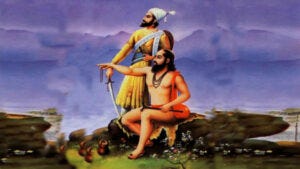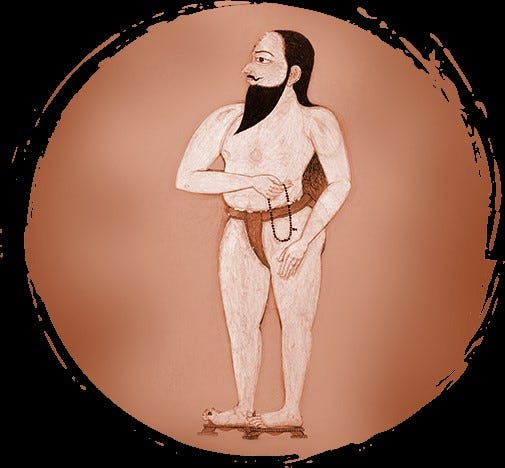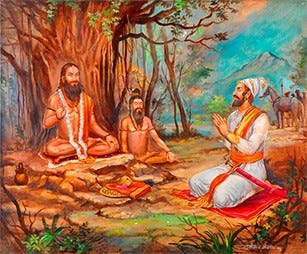Samarth Ramdas — The warrior saint

The tabletop mountain of Jaranda was bustling with activity. Common folks, priests, sannyasins, soldiers, hawkers, etc. filled every nook and corner to get a glimpse of their beloved king, the great Chhatrapati Shivaji, who prayed to Jarandeshwar Hanuman. After his puja, the poor were fed. The brahmins, the sannyasins received alms and showered blessings upon the king. A sannyasin came forward and asked for alms. The king gaped. He could not believe his eyes. Controlling his surprise, the king smiled.
Rising from his seat, the king called for a servant and asked him to bring a piece of paper. He wrote something on the piece of paper and handed it over to the Sannyasin. The latter read it and laughed, “Wise king, what would a Sannyasin do with your kingdom?”
The great king replied, “I see nothing else that I possess to be worthy enough for my Guru.”
The Sannyasin returned the paper and said, “It is not for a monk to rule a kingdom. Take it back and rule it.” Next, he tore a saffron cloth out of his robe and handed it over to Shivaji and said, “Take it as your banner and uphold Dharma.”
Shivaji bowed down to his Guru, who was known as Samarth Ramdas. While the Kshatra Tej of valiant Shivaji is celebrated, the Brahma Tej of Samarth Ramdas is relegated to the margins. Having said that, who was Samarth Ramdas?
Early Life
Samarth Ramdas was born (1608) as Narayan Thosar, in a village called Jamb, near present day Aurangabad in Maharashtra. He was born to Suryajipant and Ranubai Thosar, after his brother Gangadhar. Brought up in a pious family, Narayan was inclined to spirituality from a very early age. When he was seven, his father passed away. This event turned him introspective. He used to spend long hours in solitude, contemplating on God. Fearing that her son would turn towards Sannyas, his mother Ranubai decided to get him married. After initial resistance, he gave a promise to his mother that he would go to the wedding mandap(pavilion). However, according to legends, when he heard Shubh Mangal Saavadhan, especially the word Saavadhan(beware), he fled the ceremony.
At 12, with mind fixed in Shree Rama’s devotion, he travelled to Panchavati near Nashik and engrossed himself into deep saadhana. His day comprised intense meditation, studying scriptures. However, he believed that to support his intense saadhana, he needed a healthy body. Hence, he performed Surya namaskar (sun salutation) every day; the practice he continued throughout his life.
For 12 years, the practice continued on the banks of River Godavari. One day, the divine blessed him. He was enlightened. It is believed that Lord Rama himself initiated him as a disciple. He was at the lotus feet of Shree Rama. He became Ramdas, a devotee and servant of Shree Rama. Here is a beautiful abhang by Samarth Ramdas, with a rough translation:
रामाचें भजन तेंचि माझें ध्यान ।
तेणें समाधान पावईन ॥१॥
Singing Rama’s praise is my meditation. It brings me peace.
रामासी वर्णितां देहीं विदेहता ।
जाली तन्मयता सहजचि ॥२॥
Praising Ram is transcendental and engrossing.
राघवाचें रूप तें माझें स्वरूप ।
तेणें सुखरूप निरंतर ॥३॥
Being one with the Raghava brings me eternal bliss.
रामदास म्हणें मज एणें गती ।
राम सीतापतीचेनि नामें ॥४॥
Ramdas says, Sita Pati Rama’s name is my ultimate destiny.
Deshbhramana
Ever since Alauddin Khilji capture Devagiri fort, Maharashtra was ravaged by incessant instability and infighting. Wars between Bahamani Sultans led to strife and suffering for the poor. Women were kidnapped, villages and cities were razed to ground. Adding to this was the menace of the Mughals.
This led to a demoralized and colonized populace. Samarth Ramdas could see the lack of inner strength and fighting spirit amongst the people. Hence, he decided to tour the entire Indian Subcontinent. Like Adi Shankaracharya, with saffron robes and a wooden staff, he travelled all the way from Himalayas to Kanyakumari for 12 long years. He saw pain and suffering all around under the tyranny of Mughals.
In his pain, he remembered Lord Rama. He contemplated on the idea of creating a Ram Rajya. But he did not know how. How would he jeer a civilization which was subjugated, tortured and dispirited? As if Lord Rama graced him, Samarth Ramdas met another great saint, also a warrior; the legendary Shri Guru Gobind Singh Ji. The two great minds met in Kashmir. The great Sikh guru elaborated on the importance of bearing weapons for protecting Dharma. Moreover, he convinced Samarth Ramdas about Sangathan i.e., Organizational skills.
Samarth Ramdas returned to Maharashtra with a vision to fight the atrocities in Maharashtra. He started working on two pillars of Sangathan: Dharmasangathan and Lokasangathan. The former concerned with reigniting the fire of Spirituality and Devotion in the minds of people. The latter was about bringing people together under a common umbrella of Dharma. To accomplish both, he started establishing Mutts and temples across Maharashtra. He engaged with saints and philosophers from various sects to find common ground and create a spiritual harmony amongst people.

The guru finds his shishya.
While there was a vision and a strategy, Samarth Ramdas was looking for an able and just ruler to assume leadership. Again, Lord Rama answered his call in the form of Shivaji, the son of Shahaji Bhosle and Veer Jijamata.
Jijamata had nurtured Chhatrapati Shivaji into a skillful warrior, able administrator, shrewd politician and above all, a man who upheld Dharma. Moreover, Shivaji had already shown characteristics of a great warrior and remarkable ruler by capturing forts from Adil Shah and defying Mughals.
The two finally met in 1649, at Shinganwadi near Chaphal. There, Samarth Ramdas is believed to initiate him with Guropdesh.
As Chanakya found Chandragupta, as Shri Vidyaranya found Harihara and Bukkaraya, Samarth Ramdas found Chhatrapati Shivaji. The two met quite often to discuss strategies, philosophy, administration, etc. Shivaji drew spiritual strength from Samarth Ramdas. The great saint also shared key intelligence with Shivaji through his network of disciples across Maharashtra.

Eventually, Chhatrapati Shivaji established Hindavi Swaraj, which was built on principles of justice and acceptance. After he became the king, Chhatrapati Shivaji handed over a fort called Parali to Samarth Ramdas and asked him to establish his permanent abode. Till date, thousands of devotees and visitors travel to Sajjangad to experience the tranquility and divinity of the place.
After Chhatrapati Shivaji’s nirvana in 1680, Samarth Ramdas wrote to his son Sambhaji and urged him to emulate his father, in the following words:
शिवरायांचे आठवावे रूप । शिवरायांचा आठवावा प्रताप । शिवरायांचा आठवावा साक्षेप । भूमंडळी ।।
शिवरायांचे कैसे बोलणे । शिवरायांचे कैसे चालणे । शिवरायांची सलगी देणे । कैसे असे ।।
शिवरायांसी आठवावे । जीवित्व तृणवत मानावे । इहलोकी परलोकी उरावे । कीर्तिरूपे ।।
Remember the form of Shivaji, his valour on this earth. Remember how he spoke, the way he walked. Remember him, remember his glory.
Soon after, Samarth Ramdas attained nirvana in 1681 after reawakening and rejuvenating a civilization, after grooming civilizational icon.
Also read : An assessment of Chatrapati Shivaji’s greatness
Notable works
Samarth Ramdas’ legacy would be incomplete without the mention of the copious amount of literature and scriptures he wrote. The most prominent and famous work was Dasbodh, called as Granthraaj, by his disciples. Loosely translated as ‘advice to the disciple’, it consists of 20 sections, consisting of 10 chapters each. It draws inspiration from various scriptures and covers every aspect of life; from physiology to psychology, from politics to cosmology.
Another prominent text he wrote was Manache Shlok, meaning mild moulding melodies. It consists of quadruplets meant for the evolution of human mind.
Apart from Dasbodh and Manache Shlok, he wrote prominent works like Aatmaram, commentary on Ramayana, etc. Some of his famous hymns like Sukhakarta Dukhaharta, Maruti Stotram are widely sung and recited in Maharashtra till date.
His life and works served as an inspiration to great thinkers like Lokmanya Tilak, Hedgewar and Brahmachaitanya Maharaj, etc. His works continue to inspire millions in Maharashtra and Northern Karnataka. Lastly, the author of this piece belongs to his line of disciples and humbly bows down to Samarth Ramdas.
Notes:
- The Marathi translations are not exact ones. They capture the larger spirit of the work.
- Image Credits: Ramdas Swami Sansthan Website
- This article has been republished version of my original article on Indica Today.
